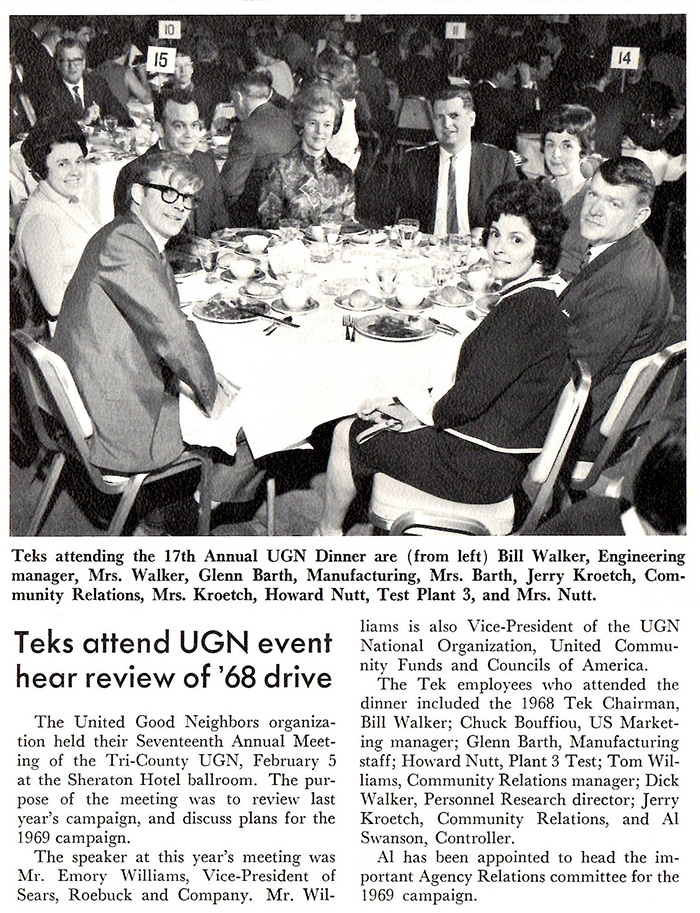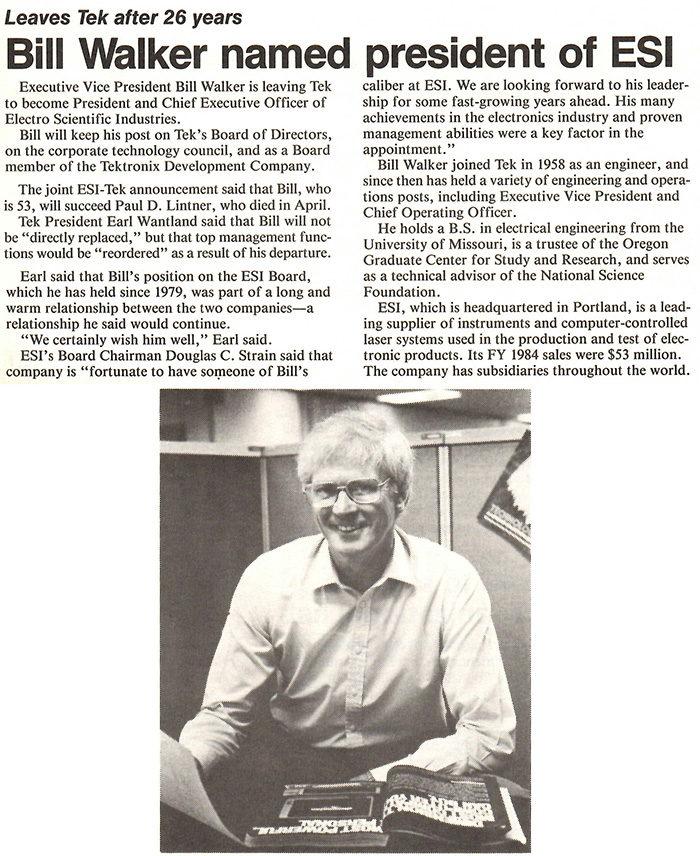Bill walker joined Tektronix in 1958 as an engineer and rose through the management chain.

The Fall/Winter 1965 issue of TekTalk featured interviews with four key employees including Bill Walker on the electronics revolution.
This July 29, 1966 TekWeek features Bill's visit to the Soviet Union for an International Electrotechnical Commission conference. Click on the image to view the PDF.
This October 2, 1964 TekWeek features Bill along with Norm Winningstad and Bill Hill visiting a United Good Neighbors agency.

This January 5, 1968 TekWeek article features Bill Walker.

This undated photo shows Bill Walker and Howard Vollum at some special event.

These two October 11, 1968 TekWeek articles feature Bill Walker and the 1968 UGN campaign. UGN was United Good Neighbors which later was renamed United Way.


This undated 1968 TekWeek also Features Bill Walker and the UGN campaign.

This undated 1968 photo features Bill receiving the past chairman pin from IEEE.

This August 20, 1971 TekWeek features Bill Walker in the 1968 WESCON booth.

This October 15, 1971 TekWeek features a transcript of a talk Bill gave on engineering. Click on the image to view the PDF.
This March 23, 1973 TekWeek features Bill Walker and Hiro Moriyasu at the press conference for the P7001.

This September 27, 1974 TekWeek features Bill speaking at the annual shareholder's meeting.

This September 26, 1975 TekWeek features Bill Walker at the annual Shareholder's meeting.

This November 1975 Engineering News article features Bill Walker discussing the new divisionalized structure for Tektronix.
This 1978 organization chart shows the Test & Measurement group's divisional structure under Bill. Click on the image to view the PDF.
This January 26, 1979 TekWeek announces Bill being named Executive Vice President and Chief Operating Office.

This March 15, 1979 issue of Electronics features an interview with Bill regarding company growth.

This 1981 TekWeek organizational chart shows the company's operations structure under Bill.

This August 21, 1981 TekWeek article features Executive VP Bill Walker speaking at an Area Rep meeting.

This November 2, 1981 Oregonian article features insight into Bill Walker and his perspective on management. Click on the image to view the PDF.
This July 22, 1983 TekWeek article features Bill Walker on emerging from the recession. Click on the image to view the PDF.
This December 4, 1981 TekWeek article features Bill Walker.

This February 1983 issue of Tek Quality features a short article by Bill on the meaning of quality. Click on the image to view the PDF.
Planar was spun out of Tektronix Solid State Research and Development group in 1983. This photo shows Bill Walker with Jim Hurd and Curt Stevens.

This bio of Bill was for the University of Missouri-Rolla and is a fairly complete history of his career at Tektronix. Click on the image to view the PDF.
This April 6, 1984 TekWeek features Bill's talk at an Area Rep meeting on the computer revolution.

This July 27, 1984 TekWeek announces Bill is leaving Tektronix to to be President of ESI.

This note was sent by Norm Winningstad on Bill's appointment to the Chairman of the ESI Board of Directors.

Bill Walker served as interim Tektronix President and Chief Operating Officer following the resignation of Tektronix President Dave Friedley on April 20, 1990. This April 27, 1990 TekWeek announces the various management changes.

These three open letters from Bill Walker appeared in the May 18, May 25, and June 15, 1990 issues of TekWeek. Click on the image to view the PDF.
This undated Tektronix Spirit was authored by Bill Walker. Click on the image to view the PDF.
This undated photo shows Bill Walker along with Charlie Rhodes, Tom Long, and Earl Wantland seated.

These three photos of Bill come from the scrapbook of Helen Fried.



Bill passed away on September 5, 2021 at age 90. Here is a short summary of his life's history.
Bill was born in the Ozarks in southern Missouri. Rarely did he speak for an extended period without referring to that heritage or his early days there. One of his first jobs was teaching school, but he later volunteered to join the US Air Force and served in the Korean War as part of a radar crew. In doing so he followed several prominent Tektronix engineers who worked with radar, including co-founder Howard Vollum, Tektronix second electrical engineer, Logan Belleville, and Bob Anderson, inventor of the Direct View Storage Tube.
It was during his time in the USAF that Bill Walker became enamored with Tektronix oscilloscopes. After his discharge from the Air Force and his graduation from the University of Missouri-Rolla, he wanted to work at Tektronix but was unsuccessful in securing an interview. He took a job with Boeing and one day in 1958 his wife alerted him that Tektronix was in town recruiting at a hotel in downtown Seattle. Bill recalled that Earl Scott, a no-nonsense engineering manager, met him at the door to the interview room and before Bill was even able to sit down, Scott asked abruptly: “what is the second integral of acceleration?”. Bill was caught off-guard, but was able answer correctly (the proper response is distance). The rest of the discussion went well and Bill was offered a job.
Early on Bill designed test systems for oscilloscopes. His work was sufficiently noteworthy that he was included in the final group of elite TEKEY employees who were given the honor of purchasing founder’s stock in 1962, prior to the IPO.
After Hewlett Packard claimed oscilloscope bandwidth supremacy in 1969, Bill played a key role in the introduction of over 100 new products in fifteen months, including re-establishing bandwidth dominance with the 500 MHz 7904. In 1971 Bill was quoted as saying: “tickle a tiger and this is what you get”.
Bill was a strong advocate for the internal development of differentiating components produced at Tektronix. The integrated circuits used in the 7000 series oscilloscopes are a prime example of such components.
Bill founded the Engineering Activities Council in the late 1970s to improve information leveling and communication among Tektronix engineers. The EAC held forums on specific topics with the intent of countering the perceived isolation between the various business unit engineering groups caused by Tek’s rapid growth.
As the company grew to over $1B in revenue and over 24,000 employees in the early 1980s, Bill was an advocate of divisionalization, restructuring the company’s business groups based on general markets rather than specific product lines. During this time he also supported groups within Tektronix to spin out of the company when it was determined their specific technology was not being used in internally. This led to the formation of Planar Systems, Anthro Corporation and TriQuint, among others.
Bill advanced rapidly through the engineering and management ranks: by 1966 he was head of the preproduction engineering group. By 1971 Bill was promoted to Engineering Group Vice President and in 1978 he was VP of Test and Measurement. In January of 1979 he was made Tektronix Executive Vice President and Chief Operating Officer.
In 1984 he left Tektronix after 26 years and joined ESI as President and CEO; he held that position for three years. When the Tektronix Board of Directors sought a fresh start for the company’s executive management in April 1990, Bill Walker was named Interim President of Tektronix. He remained on the Board of Directors after Jerry Meyer was hired in 1990.
His daughter Janis wrote this obituary. Click on the image to view the PDF.
Don Tucker had asked Bill how he ended up at Tektronix. Here is Bill's answer:
"I graduated from high school when I was only 16 due to a rural grade teacher who was lazy. In our little rural grade school there was only one teacher and she taught all eight grades. When I was in the 3rd grade we had a lazy teacher. There were only 2 of us in the 3rd grade so to reduce her number of classes she moved us both up into the 4th grade so I graduated from high school at 16. I did odd jobs around my dad's cabinet shop for about a year and someone told me that if I got 8 semester hours of college and including a couple of required courses I could then take a state exam and If I made a high enough grade on the exam I would qualify for a teaching job in the little rural schools. I borrowed $100 dollars and attended summer school about 100 miles away and rode back and forth with a rural school teacher who then helped me get a job teaching the 1st thru 4th grades in a 2 room rural school where he taught the 5th thru 8th grades. so I got the job and taught in the little rural school for 3 years. Realizing I was not getting an education very fast I joined the Air Force to qualify for the GI Bill. That was my best move. I went thru lots of AF schools where I saw my first Tektronix Scopes. I thiought they were the most beautiful things ever with their ceramic strips and hand laced cables. I was married at Keesler Air Force Base. My wife's family had moved to Oregon so it all fit. I would finish my hitch in the Air Force, Use the GI Bill to get an engineering degree; get a job with Tektronix and move to Oregon.
So... that's a short version of how I came to be out here.











